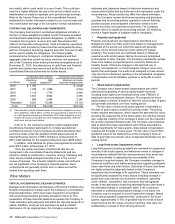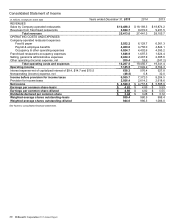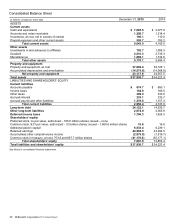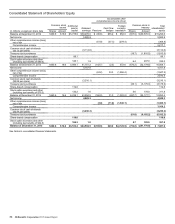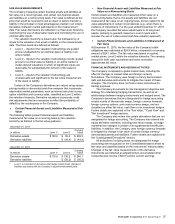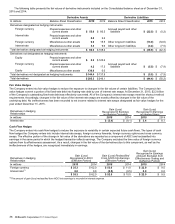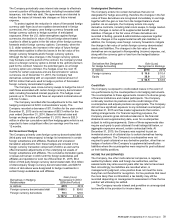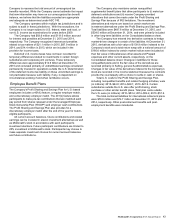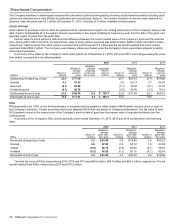McDonalds 2015 Annual Report Download - page 38
Download and view the complete annual report
Please find page 38 of the 2015 McDonalds annual report below. You can navigate through the pages in the report by either clicking on the pages listed below, or by using the keyword search tool below to find specific information within the annual report.
36 McDonald's Corporation 2015 Annual Report
SHARE-BASED COMPENSATION
Share-based compensation includes the portion vesting of all
share-based awards granted based on the grant date fair value.
Share-based compensation expense and the effect on diluted
earnings per common share were as follows:
In millions, except per share data 2015 2014 2013
Share-based compensation expense $110.0 $112.8 $ 89.1
After tax $76.0 $ 72.8 $ 60.6
Earnings per common share-diluted $0.08 $ 0.08 $ 0.06
Compensation expense related to share-based awards is
generally amortized on a straight-line basis over the vesting period
in Selling, general & administrative expenses. As of December 31,
2015, there was $98.8 million of total unrecognized compensation
cost related to nonvested share-based compensation that is
expected to be recognized over a weighted-average period of 2.0
years.
The fair value of each stock option granted is estimated on
the date of grant using a closed-form pricing model. The following
table presents the weighted-average assumptions used in the
option pricing model for the 2015, 2014 and 2013 stock option
grants. The expected life of the options represents the period of
time the options are expected to be outstanding and is based on
historical trends. Expected stock price volatility is generally based
on the historical volatility of the Company’s stock for a period
approximating the expected life. The expected dividend yield is
based on the Company’s most recent annual dividend rate. The
risk-free interest rate is based on the U.S. Treasury yield curve in
effect at the time of grant with a term equal to the expected life.
Weighted-average assumptions
2015 2014 2013
Expected dividend yield 3.6% 3.3% 3.5%
Expected stock price volatility 18.8% 20.0% 20.6%
Risk-free interest rate 1.7% 2.0% 1.2%
Expected life of options
(in years)
6.0 6.1 6.1
Fair value per option granted $10.43 $12.23 $11.09
PROPERTY AND EQUIPMENT
Property and equipment are stated at cost, with depreciation and
amortization provided using the straight-line method over the
following estimated useful lives: buildings–up to 40 years;
leasehold improvements–the lesser of useful lives of assets or
lease terms, which generally include certain option periods; and
equipment–three to 12 years.
LONG-LIVED ASSETS
Long-lived assets are reviewed for impairment annually in the
fourth quarter and whenever events or changes in circumstances
indicate that the carrying amount of an asset may not be
recoverable. For purposes of annually reviewing McDonald’s
restaurant assets for potential impairment, assets are initially
grouped together in the U.S. at a television market level, and
internationally, at a country level. The Company manages its
restaurants as a group or portfolio with significant common costs
and promotional activities; as such, an individual restaurant’s cash
flows are not generally independent of the cash flows of others in
a market. If an indicator of impairment exists for any grouping of
assets, an estimate of undiscounted future cash flows produced
by each individual restaurant within the asset grouping is
compared to its carrying value. If an individual restaurant is
determined to be impaired, the loss is measured by the excess of
the carrying amount of the restaurant over its fair value as
determined by an estimate of discounted future cash flows.
Losses on assets held for disposal are recognized when
management and the Board of Directors, as required, have
approved and committed to a plan to dispose of the assets, the
assets are available for disposal and the disposal is probable of
occurring within 12 months, and the net sales proceeds are
expected to be less than its net book value, among other factors.
Generally, such losses related to restaurants that have closed and
ceased operations as well as other assets that meet the criteria to
be considered “available for sale."
GOODWILL
Goodwill represents the excess of cost over the net tangible assets and identifiable intangible assets of acquired restaurant businesses. The
Company's goodwill primarily results from purchases of McDonald's restaurants from franchisees and ownership increases in subsidiaries or
affiliates, and it is generally assigned to the reporting unit (defined as each individual country) expected to benefit from the synergies of the
combination. If a Company-operated restaurant is sold within 24 months of acquisition, the goodwill associated with the acquisition is written
off in its entirety. If a restaurant is sold beyond 24 months from the acquisition, the amount of goodwill written off is based on the relative fair
value of the business sold compared to the reporting unit.
The following table presents the 2015 activity in goodwill by segment:
In millions U.S.
International
Lead Markets
High Growth
Markets
Foundational Markets
& Corporate Consolidated
Balance at December 31, 2014 $1,295.8 $ 777.3 $ 352.2 $ 310.0 $ 2,735.3
Net restaurant purchases (sales) (2.4) 9.4 0.8 3.8 11.6
Impairment losses 0.0 0.0 0.0 (80.4) (80.4)
Currency translation (88.6) (30.6) (31.0) (150.2)
Balance at December 31, 2015 $1,293.4 $ 698.1 $ 322.4 $ 202.4 $2,516.3
The Company conducts goodwill impairment testing in the fourth quarter of each year or whenever an indicator of impairment exists. If
an indicator of impairment exists (e.g., estimated earnings multiple value of a reporting unit is less than its carrying value), the goodwill
impairment test compares the fair value of a reporting unit, generally based on discounted future cash flows, with its carrying amount
including goodwill. If the carrying amount of a reporting unit exceeds its fair value, an impairment loss is measured as the difference
between the implied fair value of the reporting unit's goodwill and the carrying amount of goodwill. Historically, goodwill impairment has not
significantly impacted the consolidated financial statements. Accumulated impairment losses at December 31, 2015 and 2014 were $94.1
million and $13.7 million, respectively.
In connection with the Company's global restructuring, the Company evaluated the change to its new reporting segments and
determined that it is still appropriate for reporting units to be defined as each individual country when testing goodwill for impairment.


